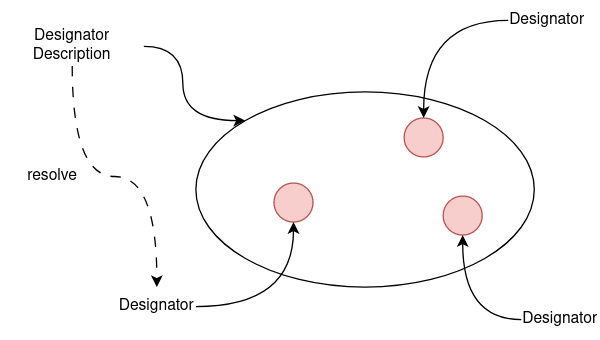Designators
Designators are CRAMs and PyCRAMs way of representing actions, motions, objects and locations.
In general, PyCRAM-Designators consist of a description and a specified element. Descriptions describe sets of designators and designators are one thing in the described set. For example, such a description could describe an action where the robot moves to a location from where it can grasp an object. The specific location in this case is not relevant as long as the robot can reach the object.
The designator description will be resolved during runtime which results in a designator with specific parameter, the resulting designator can also be performed to let the robot perform the desired behaviour.
To stay on the example of an action designator which should move the robot to a location from where it can grasp an object, we will create a NavigateAction description with a list of possible poses.
poses = [[[1, 0, 0], [0, 0, 0, 1]], [[1.2, 0.2, 0], [0, 0, 1, 0]]]
NavigateAction(target_locations=poses)
This is a description of an action which moves the robot to a pose in the environment.
In this case the description describes a set of action designators which have a pose of the poses
list as target location.
By resolving the description it will return a single designator with specific parameter. This can look like this:
designator = NavigateAction(target_locations=poses).resolve()
The resolver will check the available parameter and return a designator with appropriate parameter which can then be performed. The designator returned by the resolver will always be a sub-class of the description, in this way the designator can be assigned the type of action it performs. The resolved designator can also contain new parameter which might be relevant for performing the designator and will be inferred while resolving. A resolved action designator for a navigate action looks like this:
NavigateActionPerformable(robot_position=((0.0, 0.0, 0.0), (0.0, 0.0, 0.0, 1.0)), target_location=[[1, 0, 0], [0, 0, 0, 1]])
A visual representation of the whole idea of designator and designator descriptions can be seen in the following image.

There are four types of designators in PyCRAM:
Object Designator
Object designators represent objects in (simulated) world.
The description of object designators can take names and types that the object should match.
The ground() method returns an object with all
its data attached that matches the description.
The __iter__() method iterates over all objects
that match the description.
Contributing Object Designators
Object Designators should always be part of an object designator description.
The general class structure is seen in ObjectDesignatorDescription.
New object description need to inherit from the general object description. If the object they ground to differs from
the base object, a dataclass. should be created inside the new
description. The dataclass is one element that matches the description.
If ORM logging of the new objects is wanted a to_sql() and insert() method has to be implemented
(see orm for more details).
Action Designator
Action designators describe complex actions that are executable for an agent. Action designators can be seen as higher level plans that include failure handling and parametrization. An action designator description always takes the parameter as a list of possible parameter, when resolving the description to a single designator one parameter out of the given list will be picked.
Motion Designator
Motion designators describe atomic actions that are executable for an agent. In contrast to action
designators there is no failure handling or other action designators. Furthermore, the perform()
method passes the resolved motion designator to the respective Process Module for execution on the robot.
Another difference to action designator is that motion designators only take a single parameter instead of a list, this parameter is also strictly typed.
Location Designator
Location designator describe a set of locations in regards to specific constrains. These constrains can be things
like reachable or visible. The pose returned by a location designator is a single pose of the set defined
by the constrains given to the location designator description.
Similar to object designator poses location designator also a __iter__()
method which can iterate over all possible solutions for this description.
Creating your own Designator
Creating your own designator is fairly easy, you only need to extend the base class of the respective description.
ActionDesignatorDescription
ObjectDesignatorDescription
LocationDesignatorDescription
MotionDesignatorDescription
Afterwards you need to implement your own ground method which is the default resolver and for location and object
designator it makes sense to also implement a __iter__ method. The ground and __iter__ methods should return
the designator sub-class so you also need to implement these with the parameter your designator needs.
The sub-class can already contain some parameters, this is usually the case if the parameter is the same for every designator
of this type. For example, pycram.designators.location_designator.LocationDesignatorDescription.Location
contains a pose parameter since every location designator contains a resolved pose.
For action and motion designator the sub-class is also the place where the perform method is written which contains
the behaviour of the designator.